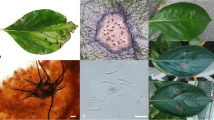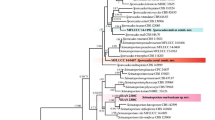Abstract
A leaf spot disease—herein named sooty leaf spot of sorghum (Sorghum bicolor)—was observed in Viçosa, Minas Gerais, Brazil. A pycnidial fungus producing fuliginous conidial masses was regularly found associated with sooty spots on leaf blades and sheaths. The fungus was isolated in pure culture from specimens collected at two localities. The examination of morphological features combined with molecular analysis of the internal transcribed spacer (ITS) region of rDNA, large subunit ribosomal ribonucleic acid (LSU rDNA) and β-tubulin region (BenA) clearly demonstrated that the two isolates were grouped in a single clade, separate from other Paraphaeosphaeria species, a new taxon. Inoculations of both isolates of the new species on maize, sugarcane and sorghum plants led to disease development only on sorghum; therefore, Koch’s postulates were fulfilled for this fungus–host association. Here, we describe the new species Paraphaeosphaeria sorghi sp. nov. as a novel fungus causing leaf spot of S. bicolor in Brazil and worldwide and represent an addition to the long list of fungal diseases of sorghum.



Similar content being viewed by others
Data availability statement
The datasets generated during and analyzed during the current study are available in the GenBank repository (http://www.ncbi.nlm.nih.gov/genbank).
References
Alfenas AC, Mafia RG (2016) Métodos em fitopatologia. Editora UFV, Viçosa, MG
Amorim L, Rezende JAM, Bergamin Filho A, Camargo LEA (2016) Manual de fitopatologia: doenças das plantas cultivadas. Agronômica Ceres, São Paulo
Aruna C, Visarada KBRS, Bhat BV, Tonapi VA (2018) Breeding sorghum for diverse end uses. Woodhead Publishing, Cambridge
Booth C (1971) Chapter II fungal culture media. In: Booth C (Eds) Methods in microbiology (Vol. 4, pp. 49–94). Academic Press. London. pp. 83
Câmara MPS, Palm ME, Berkun PV, Stewart EL (2001) Systematics of Paraphaeosphaeria: a molecular and morphological approach. Mycological Research 105:41–56
Checa J, Ramaley AW, Palm-Hernández ME, Câmara MP (2002) Paraphaeosphaeria barrii, a new species on Yucca schidigera from Mexico. Mycological Research 106:375–379
CONAB (2021) Acompanhamento da SafraBrasileira - grãos, v. 8 Safra 2020/21 – 12º levantamento. Available at: https://www.conab.gov.br/info-agro/safras/graos/boletim-da-safra-de-graos. Accessed on February 14, 2022
Cook PR, Dube AJ (1989) Host-pathogen index of plant diseases in South Australia. South Australian Department of Agriculture, Glen Osmond
Crous PW, Verkley GJM, Groenewald JZ, Houbraken J (2019) Fungal Biodiversity: Westerdijk Laboratory Manual Series. Westerdijk Fungal Biodiversity Institute, Utrecht
Dahal G, Amatya T, Manadhar HK (1992) Plant diseases in Nepal. Review of Plant Pathology 71:797–807
Dahlberg J, Berenji J, Sikora V, Latković D (2012) Assessing sorghum [Sorghum bicolor (L) Moench] germplasm for new traits: food, fuels & unique uses. Maydica 56:1750
Ding T, Li Z, Guo L, Li J (2020) First Report of Leaf Spots and Necrosis Caused by Paraphaeosphaeria recurvifoliae on Yucca gloriosa in China. Plant Disease 104:986–986
Edgar RC (2004) MUSCLE: multiple sequence alignment with high accuracy and high throughput. Nucleic Acids Research 32:1792–1797
Eriksson O (1967) Ongraminicolous pyrenomycetes from Fennoscandia 2. Phragmosporous and Scolecosporous species. Arkiv foXr Botanik ser. 2, 6: 381±440
Eriksson OE (2014) Checklist of the non-lichenized ascomycetes of Sweden. Acta Universitatis Upsaliensis, Umeå
Farr DF, Rossman AY (2022) Fungal Databases, U.S. National Fungus Collections, ARS, USDA. Available at: https://nt.ars-grin.gov/fungaldatabases/. Accessed on February 14, 2022
Fukuhara M (2002) Three Phaeosphaeria species and Paraphaeosphaeria michotii isolated from Phragmites leaves in Osaka, Japan. Mycoscience 43:0375–0382
Hedjaroude GA (1969) Études taxonomiques sur les Phaeosphaeria Miyake et leurs formes voisines (ascomycètes) (Doctoral Thèse présentée à L'ecole Polytechnique Fédérale, ETH Bibliotek, Zurich).
Hepperle D (2004) SeqAssem©. Win32–Version. Available at: http://www.sequentix.de. Accessed on October 25, 2021
Hsieh WH, Chen CY, Wang CL (2000) Taiwan Ascomycetes: Pyrenomycetes and Loculoascomycetes. China Graphics pp. 244
Kohlmeyer J, Volkmann-Kohlmeyer B, Eriksson OE (1996) Fungi on Juncus roemerianus. New marine and terrestrial ascomycetes. Mycological Research 100:393–404
Kumar S, Stecher G, Li M, Knyaz C, Tamura K (2018) MEGA X: molecular evolutionary genetics analysis across computing platforms. Molecular Biology and Evolution 35:1547–1549
Lee HB, Kim KM, Jung HS (2005) Paraphaeosphaeria recurvifoliae, a new species causing leaf spots and necrosis on Yucca recurvifolia. Fungal Diversity 20:71–81
Leslie JF (2008) Sorghum and millets diseases. John Wiley & Sons, Iowa
McCormick RF, Truong SK, Sreedasyam A, Jenkins J, Shu S, Sims D, Kennedy M, Amirebrahimi M, Weers BD, McKinley B, Mattison A, Morishige DT, Grimwood J, Schmutz J, Mullet JE (2018) The Sorghum bicolor reference genome: improved assembly, gene annotations, a transcriptome atlas, and signatures of genome organization. The Plant Journal 93:338–354
Mułenko W, Majewski T, Ruszkiewicz-Michalska M (2008) A preliminary checklist of micromycetes in Poland. W. Szafer Institute of Botany, Polish Academy of Sciences, Kraków
Nóbrega TF, Ferreira BW, Barreto RW (2021) Digitodesmium polybrachiatum sp. nov., a new species of Dictyosporiaceae from Brazil. Mycological Progress 20:1135–1144
O’Donnell K, Cigelnik E (1997) Two divergent intragenomic rDNA ITS2 types within a monophyletic lineage of the fungus Fusarium are nonorthologous. Molecular Phylogenetics Evolution 7:103–116
Peerzada AM, Ali HH, Chauhan BS (2017) Weed management in sorghum [Sorghum bicolor (L.) Moench] using crop competition: a review. Crop Protection 95:74–80
Pieczul K, Perek A (2016) First report of Paraphaeosphaeria recurvifoliae on Yucca filamentosa in western Poland. Plant Disease 100:1018–1018
Rayner RW (1970) A Mycological Colour Chart. CMI and British Mycological Society, Kew
Roane CW (2004) Graminicolous fungi of Virginia: Fungi in collections 1995–2003. Virginia Journal of Science 55:1
Roane CW (2009) Graminicolous fungi of Virginia: fungi in collections 2004–2007. Virginia Journal of Science 60:3
Roane CW, Roane MK (1997) Graminicolous fungi of Virginia: Fungi associated with genera Echinochloa to Zizania. Virginia Journal of Science 48:11–46
Rodríguez MCH, Evans HC, Abreu LM, Macedo DM, Ndacnou MK, Bekele KB, Barreto RW (2021) New species and records of Trichoderma isolated as mycoparasites and endophytes from cultivated and wild coffee in Africa. Scientific Reports 11:1–30
Shoemaker RA, Babcock CE (1985) Canadian and some extralimital Paraphaeosphaeria species. Canadian Journal of Botany 63:1284–1291
Verkley GJM, Dukik K, Renfurm R, Göker M, Stielow JB (2014) Novel genera and species of coniothyrium-like fungi in Montagnulaceae (Ascomycota). Persoonia- Molecular Phylogeny and Evolution of Fungi 32:25–51
Vilgalys R, Hester M (1990) Rapid genetic identification and mapping of enzymatically amplified ribosomal DNA from several Cryptococcus species. Journal of Bacteriology 172:4238–4246
White TJ, Bruns T, Lee S, Taylor J (1990) Amplification and direct sequencing of fungal ribosomal RNA genes for phylogenetics. In: Innis MA, Gelfand DH, Sninsky JJ, White TJ (eds) PCR protocols: a guide to methods and applications. Academic, New York, pp 315–322
Acknowledgements
We thank Dr. Adans A. Cólman for providing us with one of the isolates used in this study and preliminarily examining the fungus. This study received financial support from the Conselho Nacional de Desenvolvimento Científico e Tecnológico (CNPq).
Author information
Authors and Affiliations
Contributions
Letícia Rosa Vieira de Paula took part in methodology, investigation, validation. Robert Weingart Barreto involved in conceptualization, original collection, supervision, writing review & editing. Thaisa Ferreira da Nóbrega involved in writing—original draft, preparation, supervision.
Corresponding author
Ethics declarations
Competing interest
The authors declare that they have no known competing financial interests or personal relationships that could have appeared to influence the work reported in this paper.
Additional information
Publisher's note
Springer Nature remains neutral with regard to jurisdictional claims in published maps and institutional affiliations.
Rights and permissions
About this article
Cite this article
de Paula, L.R.V., Barreto, R.W. & da Nóbrega, T.F. Sooty leaf spot—a new fungal disease of sorghum caused by Paraphaeosphaeria sorghi sp. nov. Trop. plant pathol. 47, 618–625 (2022). https://doi.org/10.1007/s40858-022-00522-z
Received:
Accepted:
Published:
Issue Date:
DOI: https://doi.org/10.1007/s40858-022-00522-z




